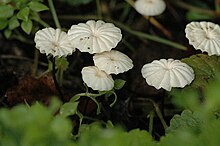
Back Marasmius AN سلعة (جنس) Arabic سلعه (جنس من الفطريات) ARZ Негніючнік BE Marasmius Catalan Marasmius CEB Špička (houba) Czech Schwindlinge German Marasmius Spanish Nööbik ET
| Marasmius | |
|---|---|

| |
| Marasmius elegans | |
| Scientific classification | |
| Domain: | Eukaryota |
| Kingdom: | Fungi |
| Division: | Basidiomycota |
| Class: | Agaricomycetes |
| Order: | Agaricales |
| Family: | Marasmiaceae |
| Genus: | Marasmius Fr. (1836) |
| Type species | |
| Marasmius rotula (Scop.) Fr. (1838)
| |
| Marasmius | |
|---|---|
| Gills on hymenium | |
| Cap is convex | |
| Hymenium is adnate | |
| Stipe is bare | |
| Spore print is white | |
| Ecology is saprotrophic | |
Marasmius is a genus of mushroom-forming fungi in the family Marasmiaceae. It contains about 500 species of agarics,[1] of which a few, such as Marasmius oreades, are edible. However, most members of this genus are small, unimpressive brown mushrooms. Their humble appearance contributes to their not being readily distinguishable to non-specialists, and they are therefore seldom collected by mushroom hunters. Several of the species are known to grow in the characteristic fairy ring pattern.

The author of the genus was Elias Magnus Fries,[2] who in 1838[3] classified white-spored agarics having a tough central stipe in this taxon if they were marcescent, i.e. they could dry out but later revive when moistened. For Fries, marcescence—by contrast with the "putrescent" (decomposing) nature of most mushrooms—was an important character for classification, which he used to separate this group from genus Collybia (which has now been split into many newer genera). The name Marasmius itself comes from the Greek word marasmos, meaning "drying out; withering". Modern mycologists no longer consider the marcescence/putrescence distinction a reliable criterion for taxonomy, but Fries's definition of the genus is still roughly applicable.
- ^ Cite error: The named reference
Kirk2008was invoked but never defined (see the help page). - ^ See record in Index Fungorum
- ^ E. M. Fries Epicrisis systematis mycologici (1838) Uppsala: Typographia Academica